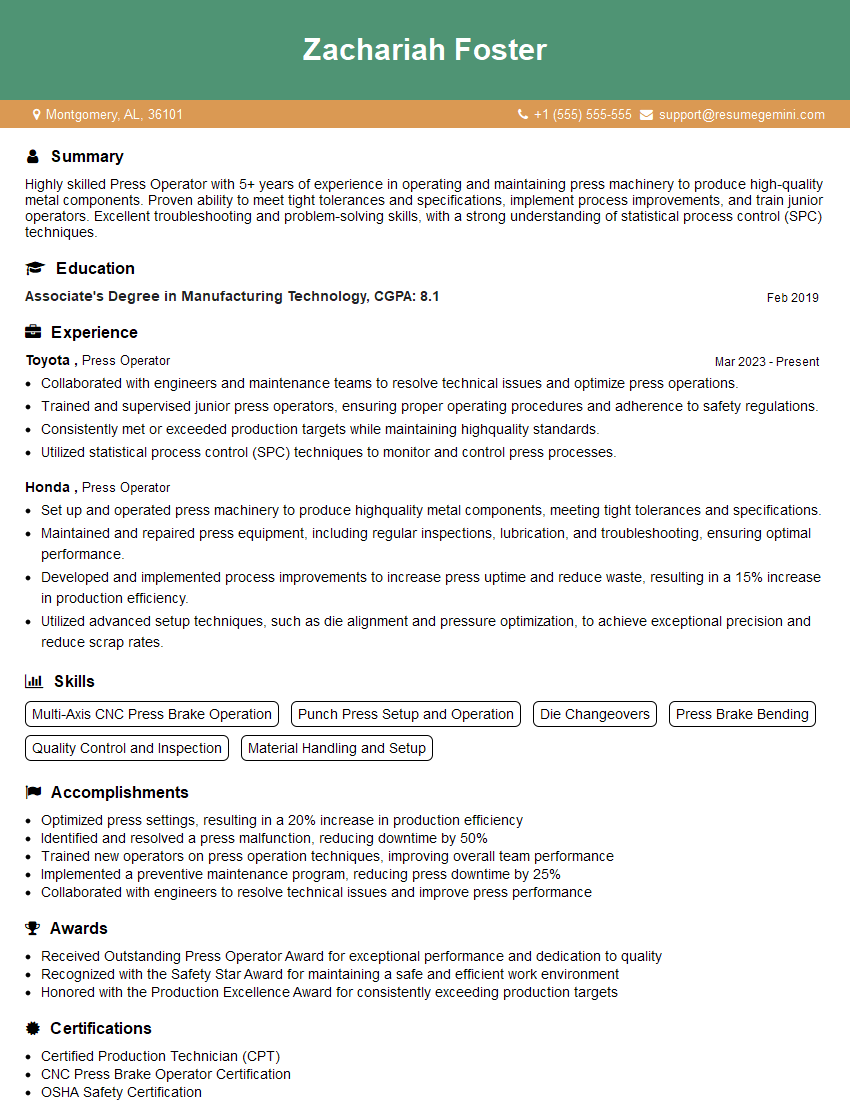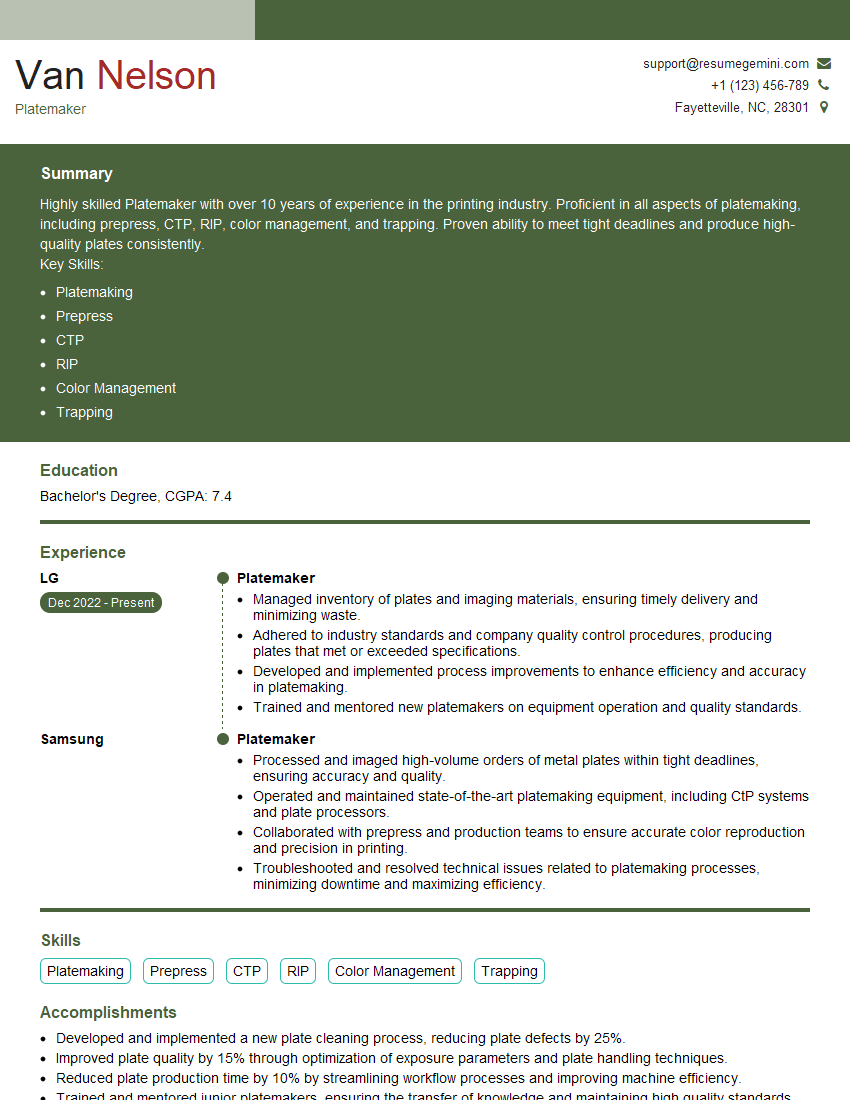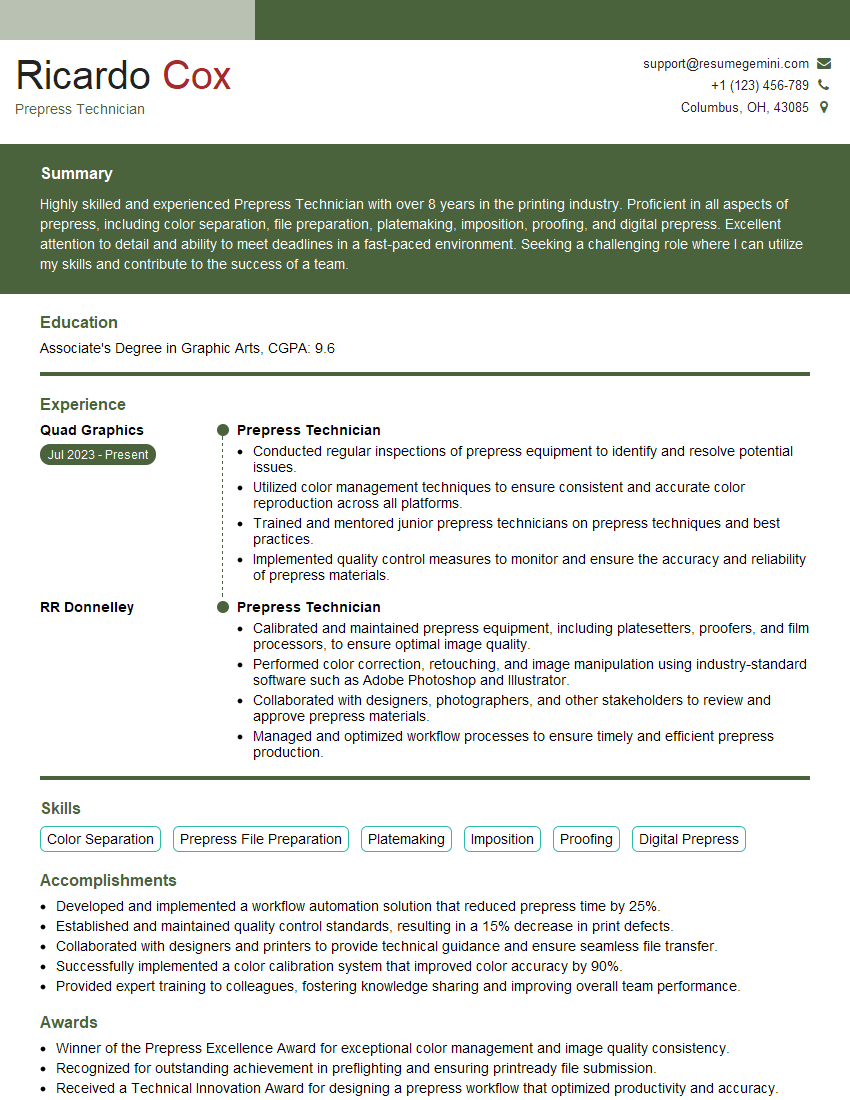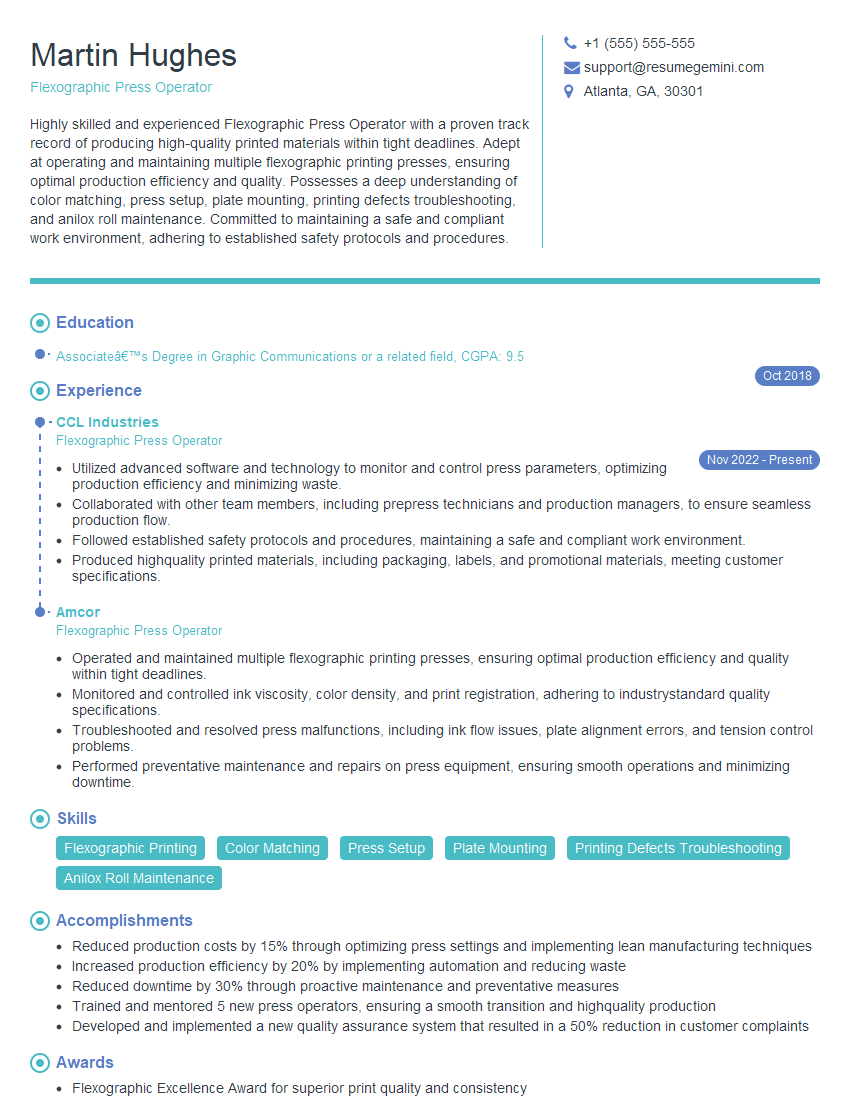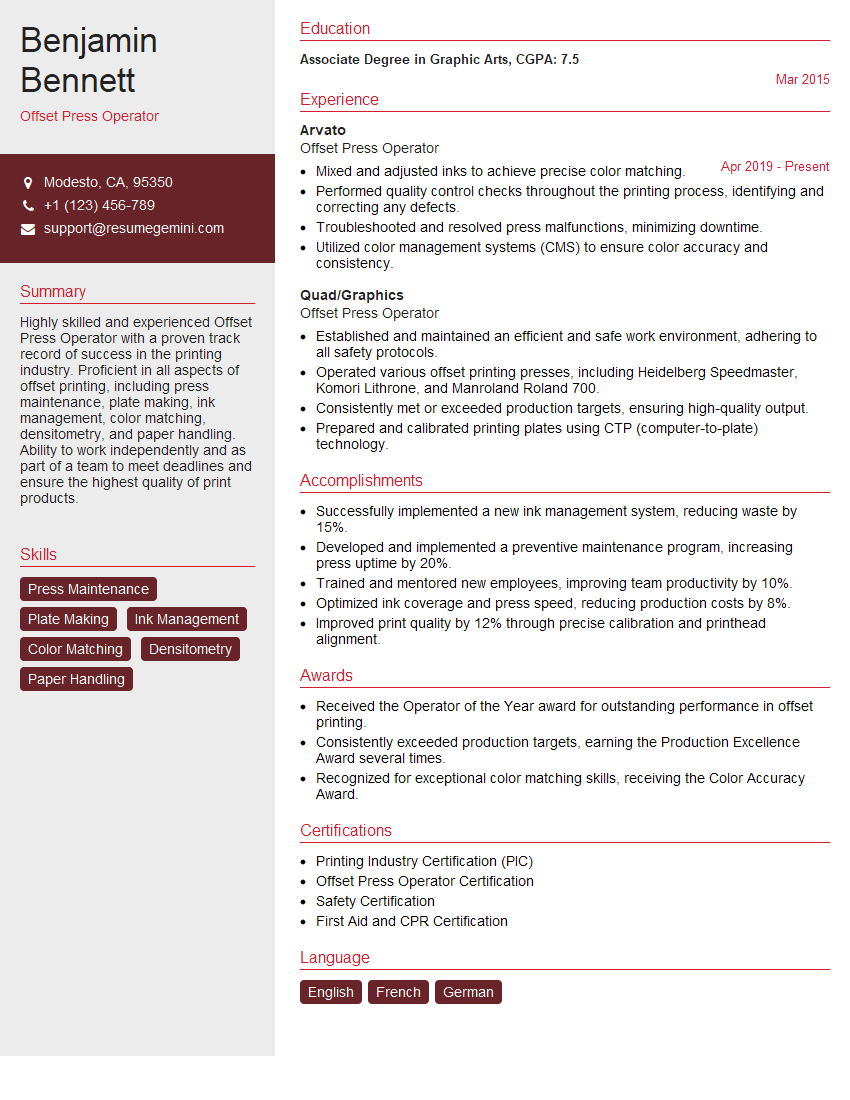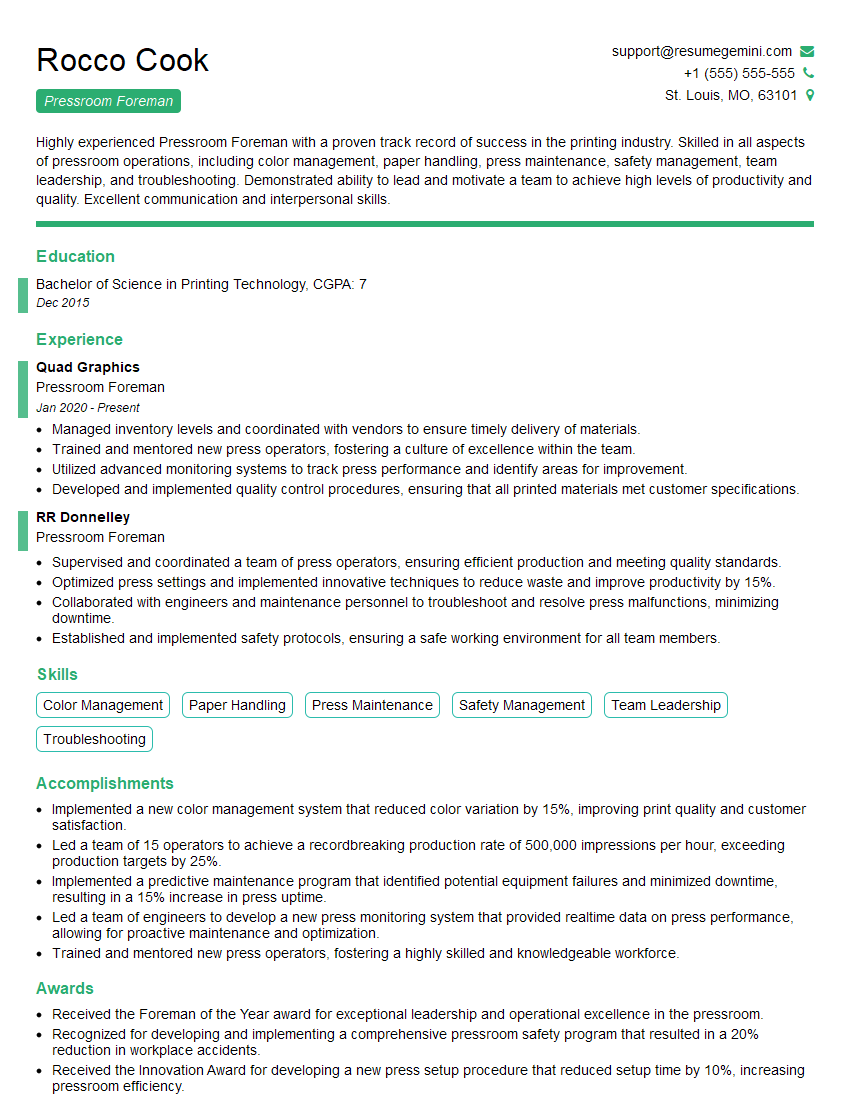Are you ready to stand out in your next interview? Understanding and preparing for Press Optimization and Efficiency interview questions is a game-changer. In this blog, we’ve compiled key questions and expert advice to help you showcase your skills with confidence and precision. Let’s get started on your journey to acing the interview.
Questions Asked in Press Optimization and Efficiency Interview
Q 1. Explain the difference between makeready time and run time in a printing press.
In the printing world, ‘makeready’ and ‘run’ time represent distinct phases of a printing job. Makeready time encompasses all the preparatory steps before actual printing begins. Think of it as the ‘getting ready’ stage. This includes tasks like mounting plates, adjusting ink and water balances, setting up the paper feed, and performing color calibrations. It’s essentially the time spent configuring the press for optimal printing. Run time, conversely, is the actual printing time – the period where the press is actively producing printed sheets. It’s the ‘printing’ stage. Minimizing makeready time is crucial for press efficiency because it directly impacts overall production speed and profitability.
Example: Imagine printing a 10,000-sheet job. Makeready might take 2 hours, while the run time is 8 hours. A shorter makeready time means we free up the press for other jobs more quickly and improve our throughput.
Q 2. Describe your experience with color management in a pressroom setting.
Color management in a pressroom is a critical aspect of achieving consistent, high-quality output. My experience involves working with various color management systems, including spectrophotometers and densitometers, to ensure accurate color reproduction. This includes creating and using ICC profiles, which are like digital fingerprints of the press and its substrates. They help translate the designer’s intended colors into the printed reality. I’ve also been heavily involved in calibrating the press using test strips and color bars to fine-tune the ink and water balances, achieving the desired color gamut and minimizing color variations across the entire print run. Furthermore, I have experience working with different color spaces (CMYK, RGB) to ensure accurate conversion between digital files and the press.
Practical Application: In a recent project involving a high-end packaging job, careful color management ensured the final printed boxes matched the client’s brand colors precisely, preventing costly reprints and maintaining brand consistency.
Q 3. How do you troubleshoot common press problems, such as slurring or misregistration?
Troubleshooting press problems requires a systematic approach. For instance, slurring (blurred print) often stems from issues with ink viscosity, roller settings, or dampening system malfunctions. I start by checking the ink’s properties, ensuring it’s not too thin or thick. Then, I meticulously examine the rollers, looking for any wear or damage, and adjust the roller pressure accordingly. The dampening system’s consistency is crucial; imbalances can lead to both slurring and misregistration. Similarly, misregistration (images not aligning correctly) can result from problems with the feeding system (paper skew), gripper bar issues, or incorrect plate mounting. A thorough inspection of the paper path, careful plate alignment, and adjustments to the impression cylinder are key steps in resolving misregistration.
Step-by-Step Approach to Slurring:
1. Inspect ink: Check viscosity and adjust accordingly.
2. Examine rollers: Look for wear, clean, and adjust pressure.
3. Check dampening system: Ensure uniform distribution.
4. Adjust ink keys: Fine-tune ink distribution.
5. Check impression cylinder: Ensure correct pressure.
Q 4. What are the key metrics you use to measure press efficiency?
Key metrics for measuring press efficiency include: Overall Equipment Effectiveness (OEE), which considers availability, performance, and quality; makeready time; run time; waste percentage; speed (sheets per hour); and cost per printed piece. Tracking these metrics provides crucial insights into areas of improvement and helps us optimize press performance. OEE gives a holistic view by combining uptime with speed and quality. Lower makeready times and higher speeds mean increased output. Reducing waste percentages translates directly to cost savings. By analyzing these metrics regularly, we can identify bottlenecks and implement necessary changes.
Example: By analyzing OEE data, we identified a recurring issue with paper jams, reducing availability. Implementing preventative maintenance and adjusting feed settings improved OEE and increased output by 15%.
Q 5. How do you optimize ink usage and reduce waste?
Optimizing ink usage and reducing waste involves several strategies. Proper ink formulation and adjustments are paramount. Precise color matching minimizes ink consumption while achieving the required color fidelity. Implementing techniques such as ink-saving settings on the press (like reducing ink density where possible) is also key. Regular cleaning and maintenance of the ink ducts and rollers prevent ink waste due to leakage or build-up. Using consistent substrates reduces variation and avoids waste due to press adjustments. Employing pre-press technologies like careful imposition and preflight checks can also contribute to higher efficiency by minimizing errors that necessitate reprints.
Example: Implementing a new ink management system resulted in a 10% reduction in ink consumption without compromising print quality.
Q 6. Explain your experience with different types of printing presses (e.g., offset, digital, flexo).
My experience spans various printing technologies. I’ve worked extensively with offset printing, handling large-format commercial printing jobs and mastering the intricacies of sheet-fed and web offset presses. I’m also familiar with digital printing, particularly its advantages for short runs, personalization, and quick turnaround times. My understanding includes its limitations in terms of cost-effectiveness for high-volume jobs. Lastly, I have experience with flexographic printing, specifically in packaging applications, understanding its ability to print on flexible substrates such as films and foils and its adaptability to high-speed production.
Each technology presents unique challenges and opportunities; the choice depends on the job’s requirements and volume.
Q 7. Describe your approach to maintaining press quality and consistency.
Maintaining press quality and consistency requires a multi-pronged approach. Regular preventative maintenance is crucial. This includes scheduled inspections and cleaning of all press components, including rollers, dampening systems, and ink fountains. Precise monitoring of ink and water balances, paper quality, and temperature and humidity conditions are essential. Using standardized procedures and checklists ensures consistent operation. Operator training is key; skilled operators can identify and address minor issues before they escalate into major problems. Employing a robust quality control process, involving regular checks of printed sheets throughout the run, guarantees high quality and consistent output. Consistent use of calibrated equipment is essential for consistency.
Example: Implementing a daily press check list and regular training sessions decreased the number of print errors by 12%.
Q 8. How do you manage press maintenance schedules and preventative maintenance?
Press maintenance is the cornerstone of efficient and high-quality printing. Managing it effectively involves a proactive, preventative approach, rather than a reactive one. I utilize a Computerized Maintenance Management System (CMMS) to schedule and track all maintenance activities. This system allows me to create detailed schedules based on manufacturer recommendations, operational hours, and historical data on equipment failures.
Preventative maintenance includes regular cleaning, lubrication, inspections, and part replacements according to a predefined schedule. For example, a Heidelberg Speedmaster might require daily checks of ink rollers and dampening systems, weekly cleaning of the impression cylinder, and monthly inspections of the inking unit. Beyond scheduled maintenance, we conduct regular operational checks throughout the day to catch minor issues before they escalate. This might involve daily checks of the paper feed, register, and print quality. A key metric we monitor is Mean Time Between Failures (MTBF) to identify areas for improvement in our preventative maintenance program.
Using a CMMS allows for detailed records of maintenance performed, which is crucial for tracking the health of our equipment and reducing unplanned downtime. The data collected helps identify patterns and predict potential failures, allowing us to schedule maintenance proactively, maximizing press uptime and reducing repair costs. It also ensures compliance with safety regulations and helps optimize maintenance resource allocation.
Q 9. What software or systems are you familiar with for press optimization and workflow management?
My experience encompasses a range of software and systems used for press optimization and workflow management. I’m proficient in MIS (Management Information Systems) like EFI PrintSmith Vision and Tharstern, which help manage jobs, track costs, and schedule production efficiently. These systems allow for real-time monitoring of press performance, helping us identify bottlenecks and optimize schedules. I’m also familiar with prepress software like Adobe Acrobat and Esko Automation Engine, vital for ensuring proper file handling and color management.
Furthermore, I’ve worked with various press control systems, including those on Heidelberg, Komori, and Mitsubishi presses. These systems provide detailed data on press performance, such as speed, ink usage, and waste. This data is crucial for optimizing press settings and improving overall efficiency. My experience also includes working with workflow automation software that integrates prepress, press, and postpress operations, streamlining the entire printing process and reducing errors. For example, a JDF (Job Definition Format)-based workflow system can automate the transfer of job information between different stages, ensuring consistency and accuracy.
Q 10. How do you work with prepress to ensure proper file preparation and color accuracy?
Collaboration with prepress is essential for achieving optimal print results. I work closely with the prepress team to ensure proper file preparation and color accuracy from the outset. This starts with clear communication regarding job specifications, including substrates, ink types, and desired color profiles. We utilize standardized color profiles (e.g., ISO Coated v2) and proofing systems to ensure color consistency across different stages of production.
Before the job goes to press, we conduct rigorous preflight checks to identify any potential problems, such as missing fonts, low-resolution images, or incorrect color spaces. We use tools like Adobe Acrobat Pro and GMG ColorServer to validate files and make necessary corrections. The prepress team also plays a vital role in creating accurate color proofs, which we review and approve before starting the press run. This collaborative process ensures that the final print meets the client’s expectations and reduces the risk of costly reprints or delays.
We regularly hold meetings with the prepress team to review best practices and address any challenges. This open communication ensures that everyone is on the same page and that any issues are addressed promptly. For instance, we might discuss potential issues with specific file formats or address inconsistencies in color management. This collaborative approach leads to a smoother workflow and superior print quality.
Q 11. Explain your understanding of different paper types and their impact on press performance.
Understanding paper types is critical for optimizing press performance. Different paper types exhibit varying characteristics that impact press speed, ink absorption, and overall print quality. For example, coated papers generally offer sharper image reproduction and brighter colors due to their smooth surface. However, they may require adjustments in ink density and dampening to prevent mottling or ink drying issues.
Uncoated papers, on the other hand, provide a more natural feel and often offer better ink absorption, making them suitable for certain applications, like letterpress or offset printing. However, they can be more prone to show through or require adjustments in the press settings to prevent issues like slurring. Different weights and finishes (glossy, matte, etc.) also affect the press performance. Heavier stocks demand higher press power and potentially slower speeds, while a rougher finish could lead to increased ink consumption.
I regularly consult paper specification sheets to understand the properties of each paper grade and adjust the press accordingly. This might involve changing the impression pressure, ink viscosity, or dampening balance to achieve optimal results. Careful selection of paper type is crucial not only for aesthetics but also for efficiency. Choosing a paper that’s compatible with our press and the job requirements minimizes waste and maximizes productivity. For instance, using a lighter weight paper can significantly reduce paper costs and improve printing speed.
Q 12. Describe a time you had to solve a complex press problem.
During a high-volume print job for a major catalog, we experienced a recurring problem with ghosting (a faint, shadowed image appearing next to the main image). It was particularly frustrating as it only appeared intermittently and didn’t manifest consistently. Initial troubleshooting focused on the usual suspects: ink balance, dampening, and impression pressure. But these adjustments produced minimal results, and the ghosting persisted.
We systematically analyzed the problem by conducting various tests, including eliminating variables one by one. We carefully examined the plates, ruling out plate defects. We changed ink batches and dampening solutions. Ultimately, it was discovered that the issue stemmed from a subtle problem with the blanket cylinder. While visually, the cylinder seemed flawless, there was a microscopic imperfection in the surface causing inconsistent pressure distribution.
The solution involved precision polishing of the blanket cylinder. Afterward, rigorous testing and monitoring of the press parameters were undertaken to ensure that the issue was resolved. The experience highlighted the importance of methodical troubleshooting, careful examination of even seemingly minor components, and the collaboration between press operators and maintenance technicians to overcome complex challenges. The successful resolution also underscores the value of investing in appropriate maintenance and having a deep understanding of press mechanics.
Q 13. How do you handle press downtime and minimize its impact on production?
Press downtime is costly, so minimizing its impact is crucial. My approach focuses on proactive measures to prevent downtime and efficient strategies to manage it when it occurs. Our preventative maintenance program, as discussed earlier, is key to reducing unplanned downtime. This includes regular inspections, timely servicing, and keeping a well-stocked inventory of common spare parts. In addition, we utilize predictive maintenance techniques – analyzing data from the press control systems to identify potential failures before they occur.
When downtime does occur, I follow a structured approach. First, identify the cause of the problem through rigorous troubleshooting – this involves checking all the possible sources of the problem including mechanics, power supply, and software. Second, if the issue requires specialized repair, I initiate procedures for contacting external service technicians, ensuring swift arrival and resolution. Finally, during downtime, we implement contingency plans to redirect urgent jobs to alternative presses or external printers to avoid delays in fulfilling customer orders. It also involves transparent communication with clients about any potential delays, keeping them informed of the progress being made.
A detailed log of all downtime events, including root causes and resolution times, helps identify recurring problems and provides insights for improving maintenance procedures. We use this data to analyze the overall Equipment Effectiveness (OEE) and identify areas for continuous improvement. This proactive approach and efficient resolution strategy help keep downtime to a minimum, maintaining production flow and customer satisfaction.
Q 14. What is your experience with Lean Manufacturing principles in a pressroom environment?
Lean Manufacturing principles are highly relevant in a pressroom environment. My experience involves applying these principles to improve efficiency, reduce waste, and optimize production flows. This includes implementing techniques like 5S (Sort, Set in Order, Shine, Standardize, Sustain) to organize the workspace, eliminating clutter, and improving workflow. It’s about creating a safe and efficient working environment. For example, keeping all tools in designated places and establishing consistent cleaning routines.
We utilize value stream mapping to visualize the entire printing process, identifying bottlenecks and non-value-added activities. This helps us optimize the workflow, reducing lead times and improving overall productivity. For example, eliminating unnecessary steps in the process such as redundant quality checks or excessive movement of materials. We apply Kaizen (continuous improvement) methodologies, encouraging staff to identify and suggest improvements to processes. This could involve simplifying setups, reducing waste, or improving the efficiency of a particular task. Employee involvement is key here.
Another key aspect is the implementation of Total Productive Maintenance (TPM), which involves empowering all employees to participate in the maintenance and improvement of the equipment. We measure key performance indicators (KPIs) like OEE, press speed, and waste to track progress and identify areas for improvement. This data-driven approach ensures that our lean initiatives are effective and deliver tangible results. Through continuous improvement efforts, we continuously seek to maximize efficiency and minimize waste across all aspects of pressroom operations.
Q 15. How do you train and supervise press operators?
Training press operators is a multifaceted process focusing on safety, technical proficiency, and problem-solving skills. It begins with a structured onboarding program covering safety regulations, machine operation, and quality control procedures. We use a combination of classroom instruction, hands-on training with experienced mentors, and simulations to ensure operators understand the intricacies of the press. Supervision involves ongoing performance monitoring, regular feedback sessions, and continuous skill development through workshops and training modules. For example, we might use a phased approach, starting with simple tasks under close supervision before gradually increasing complexity and responsibility. Regular competency assessments ensure operators consistently meet performance standards and identify areas needing improvement. We also utilize real-time data from the press to provide feedback and identify areas for improvement in operator technique.
Career Expert Tips:
- Ace those interviews! Prepare effectively by reviewing the Top 50 Most Common Interview Questions on ResumeGemini.
- Navigate your job search with confidence! Explore a wide range of Career Tips on ResumeGemini. Learn about common challenges and recommendations to overcome them.
- Craft the perfect resume! Master the Art of Resume Writing with ResumeGemini’s guide. Showcase your unique qualifications and achievements effectively.
- Don’t miss out on holiday savings! Build your dream resume with ResumeGemini’s ATS optimized templates.
Q 16. How do you monitor and improve press productivity?
Monitoring and improving press productivity requires a data-driven approach. We leverage key performance indicators (KPIs) such as Overall Equipment Effectiveness (OEE), press speed, waste percentage, and job turnaround time. Regular monitoring of these KPIs helps identify bottlenecks and areas for optimization. For instance, if waste percentages are consistently high, we investigate potential causes like improper plate alignment or ink settings. We utilize software solutions that track press performance in real-time, generating reports that highlight trends and potential issues. Improvements are implemented through several strategies, including scheduled maintenance, operator training, process optimization (such as implementing lean manufacturing principles), and investing in advanced press technologies. A specific example: We found that by implementing a new automated plate-changing system, we reduced setup time by 20%, significantly increasing overall productivity.
Q 17. What are some common causes of press stoppages, and how do you prevent them?
Press stoppages are costly and disruptive. Common causes include paper jams, ink problems (such as drying too quickly or insufficient ink flow), mechanical malfunctions (worn parts, faulty sensors), and operator errors. Preventing these stoppages involves a multi-pronged approach. Preventive maintenance is crucial – regularly scheduled inspections and servicing of the press minimize the risk of mechanical failures. We also focus on proper material handling to prevent paper jams. Operator training is key to reducing errors. A robust quality control system, including regular checks of ink viscosity and plate condition, helps identify and address potential problems before they lead to stoppages. Finally, a well-maintained press with the right settings for the job significantly minimizes the chance of unexpected downtime. For instance, we implemented a predictive maintenance program using sensor data to anticipate potential failures and schedule maintenance proactively, reducing unplanned stoppages by 30%.
Q 18. Describe your experience with different types of printing inks.
My experience encompasses a wide range of printing inks, including UV (ultraviolet)-cured, water-based, solvent-based, and vegetable-based inks. Each ink type presents unique characteristics and requires specific handling procedures. UV inks offer vibrant colors and fast drying times but require specialized equipment. Water-based inks are environmentally friendly but can have limitations in terms of color vibrancy and drying speed. Solvent-based inks provide excellent print quality but require careful handling due to their volatile organic compounds (VOCs). Vegetable-based inks offer a more sustainable alternative but often require adjustments in press settings. Understanding the properties of each ink type is essential for achieving optimal print quality, ensuring press efficiency, and maintaining safety standards. For example, I’ve worked extensively on optimizing press settings for UV-cured inks to achieve a balance between speed, color accuracy, and curing efficiency.
Q 19. How do you ensure the proper cleaning and maintenance of printing plates?
Proper cleaning and maintenance of printing plates are crucial for consistent print quality and press efficiency. This involves a systematic cleaning process, starting with removing excess ink using a specialized cleaning solution. We then use a plate cleaner designed for the specific type of plate being used, ensuring it’s compatible and won’t damage the plate surface. Plates are meticulously inspected for scratches, damage, or ink build-up. Storage is equally important; plates are stored in a clean, dry environment, protected from dust and damage. Regular maintenance includes inspection for wear and tear, potentially requiring re-etching or replacement. A specific example is the implementation of a computerized plate cleaning system that precisely controls the cleaning process and reduces plate wear.
Q 20. Explain your experience with quality control procedures in the printing process.
Quality control is an integral part of the printing process, implemented at various stages. Beginning with pre-press checks, we verify that the artwork is correct, the color profiles are accurate, and the plates are properly prepared. During the printing process, regular color checks and print quality inspections are conducted, using densitometers and other quality control instruments. We establish clear acceptance criteria and maintain detailed records of print runs. This includes tracking waste, identifying defects, and recording any adjustments made. In the post-press stage, we perform final inspections to ensure that the final product meets the client’s specifications and quality standards. Non-conformances are documented, investigated, and corrective actions are implemented to prevent recurrence. For example, we utilize Statistical Process Control (SPC) charts to monitor key quality parameters and identify potential trends before they become major issues.
Q 21. How familiar are you with waste reduction strategies in the print industry?
Waste reduction is a critical concern in the printing industry, both environmentally and economically. Strategies focus on minimizing paper waste through accurate job estimations, efficient press setup, and optimized material handling. We employ techniques like ‘nesting’ to maximize the use of paper sheets, reducing waste from trimming. Ink optimization, including using the correct ink amount and minimizing ink spills, also plays a vital role. Regular maintenance of the press prevents ink and paper waste due to malfunctions. Implementing a robust quality control system minimizes re-runs and waste caused by print defects. Recycling programs for waste paper and ink cartridges are essential parts of our sustainable practices. For example, we implemented a software system that optimizes the layout of printing jobs, reducing paper waste by 15%.
Q 22. Describe your understanding of press automation and its benefits.
Press automation involves integrating technology to streamline and automate various stages of the printing process, from pre-press to post-press. Think of it like an assembly line, but for printing! Instead of manual adjustments and interventions, automated systems handle tasks like plate changing, ink adjustments, and even quality checks.
The benefits are significant: Increased productivity, reduced waste, improved print quality consistency, and decreased labor costs. For example, automated plate changing can reduce makeready time by up to 50%, allowing for quicker turnaround and more jobs completed in a day. Similarly, automated ink controls minimize waste from color adjustments and ensure consistent color across large print runs.
- Faster Makeready: Reduced setup time translates to more efficient use of the press.
- Consistent Quality: Automated controls minimize variations in color and registration.
- Reduced Waste: Precise ink and paper usage minimizes material loss.
- Increased Throughput: More jobs completed within the same timeframe.
- Improved Safety: Automation reduces the need for manual handling of heavy materials, enhancing safety.
Q 23. What is your experience with different types of printing substrates (paper, cardboard etc.)?
My experience encompasses a wide range of printing substrates, from standard offset paper stocks – including coated, uncoated, and various weights – to more specialized materials like cardboard, corrugated board, and various types of plastics and synthetics used in specialized packaging printing. Understanding the properties of each substrate is crucial. For instance, coated paper offers excellent image reproduction but might be prone to scratching, while uncoated paper is more porous and absorbs ink differently, affecting color vibrancy. Working with cardboard demands different press settings to accommodate its thickness and texture.
I’ve worked with substrates requiring specific handling to avoid damage or misalignment during the printing process. This includes understanding moisture content, which can significantly impact the outcome, especially with thicker materials. Each substrate presents unique challenges and requires careful adjustments to the printing process to achieve optimal results.
Q 24. How do you manage inventory of printing consumables (inks, plates, paper)?
Managing inventory of printing consumables requires a robust system that combines forecasting, stock control, and efficient ordering processes. I typically use a combination of techniques including:
- Demand Forecasting: Analyzing historical data to predict future needs based on job schedules and anticipated demand.
- Just-in-Time (JIT) Inventory: Minimizing storage costs and reducing the risk of obsolescence by ordering consumables just before they are needed.
- Minimum/Maximum Stock Levels: Setting minimum and maximum inventory levels for each consumable to ensure sufficient stock while avoiding overstocking.
- Regular Stock Audits: Conducting periodic physical counts to reconcile actual stock levels with the inventory management system.
- Inventory Management Software: Using software to track inventory levels, automate ordering, and generate reports.
For example, if we anticipate a large print run requiring a specific ink, I’ll ensure we have sufficient supply, considering lead times for ordering and delivery. This proactive approach prevents delays and ensures the smooth operation of the pressroom.
Q 25. What are your strategies for improving communication and collaboration in a pressroom team?
Effective communication and collaboration are paramount in a pressroom environment. My approach focuses on several key strategies:
- Regular Team Meetings: Holding daily or weekly briefings to discuss upcoming jobs, potential challenges, and any issues requiring attention. This keeps everyone informed and fosters a sense of teamwork.
- Open Communication Channels: Establishing clear communication channels, such as instant messaging or dedicated communication boards, for quick problem-solving and information sharing.
- Clear Job Instructions: Providing precise and detailed job instructions to ensure everyone understands their roles and responsibilities.
- Cross-Training: Training team members in multiple areas to increase flexibility and efficiency. This reduces reliance on single individuals and allows for better coverage in case of absences.
- Feedback Mechanisms: Creating a culture where team members feel comfortable providing feedback and suggestions for improvement.
For instance, a quick message on our communication board about a potential paper jam allows for quicker response and prevents prolonged downtime. Open communication fosters a positive and collaborative work environment, leading to higher efficiency and productivity.
Q 26. How do you ensure compliance with safety regulations in the pressroom?
Ensuring compliance with safety regulations is a top priority. My approach involves a multi-faceted strategy:
- Regular Safety Training: Providing ongoing safety training to all pressroom personnel, covering topics such as lockout/tagout procedures, machine operation, handling hazardous materials, and proper use of personal protective equipment (PPE).
- Regular Safety Audits: Conducting routine safety inspections to identify and address potential hazards.
- Emergency Response Plans: Developing and implementing emergency response plans to handle various scenarios, such as fire, chemical spills, or equipment malfunctions.
- PPE Enforcement: Strictly enforcing the use of appropriate PPE, including eye protection, hearing protection, and gloves.
- Machine Maintenance: Ensuring regular maintenance of printing presses and related equipment to prevent accidents.
Regular training and adherence to safety protocols aren’t just compliance measures; they create a safer, more productive work environment. For example, regular machine maintenance prevents unexpected breakdowns that can lead to accidents.
Q 27. Describe your experience with analyzing press data to identify areas for improvement.
Analyzing press data is crucial for identifying areas for improvement. Modern presses generate vast amounts of data on various parameters like speed, ink consumption, waste, and makeready times. I leverage this data to optimize press performance. My approach involves:
- Data Collection: Gathering data from various sources, including the press itself, the MIS (Management Information System), and quality control reports.
- Data Analysis: Using statistical methods and data visualization tools to identify trends and patterns in the data.
- Identifying Bottlenecks: pinpointing areas where inefficiencies exist, such as excessive makeready times or high waste rates.
- Implementing Solutions: Developing and implementing corrective actions based on the analysis, which could involve adjusting press settings, improving workflows, or addressing equipment issues.
- Continuous Monitoring: Continuously monitoring performance metrics to track the effectiveness of improvements and identify new opportunities for optimization.
For example, by analyzing data on ink consumption, I might discover that a particular color is consistently over-used. This could indicate a problem with the ink settings or a need for better color calibration.
Q 28. How do you stay up-to-date with the latest advancements in printing technology?
Staying current with advancements in printing technology is essential for maintaining a competitive edge. My approach includes:
- Industry Publications and Websites: Regularly reading industry publications, attending webinars, and visiting relevant websites to stay informed about the latest trends and technologies.
- Trade Shows and Conferences: Attending trade shows and conferences to see new equipment and technologies in action and network with other professionals.
- Vendor Relationships: Maintaining strong relationships with equipment vendors to learn about new product releases and updates.
- Continuing Education: Participating in continuing education courses and workshops to enhance my knowledge and skills.
- Online Courses and Certifications: Taking advantage of online resources and certifications to stay updated on specific technologies.
For example, I recently completed a training course on the latest advancements in UV printing, expanding my knowledge base and providing valuable insights into this increasingly popular printing method.
Key Topics to Learn for Press Optimization and Efficiency Interview
- Press Setup and Configuration: Understanding different press types, their capabilities, and optimal settings for various printing jobs. Practical application: Troubleshooting setup issues and optimizing for speed and quality.
- Waste Reduction Strategies: Identifying and minimizing waste through efficient material handling, accurate job planning, and proactive maintenance. Practical application: Implementing lean manufacturing principles within a print environment.
- Color Management and Calibration: Achieving consistent and accurate color reproduction across different printing processes. Practical application: Using color profiles and calibration tools to ensure brand consistency.
- Ink Optimization: Understanding ink properties, ink usage calculations, and techniques for minimizing ink consumption without sacrificing quality. Practical application: Analyzing ink usage data and implementing strategies for cost reduction.
- Press Maintenance and Troubleshooting: Proactive maintenance schedules, preventative measures, and effective troubleshooting of common press malfunctions. Practical application: Performing routine checks, identifying potential problems, and implementing solutions to minimize downtime.
- Production Scheduling and Workflow: Optimizing the workflow to ensure efficient production scheduling, minimizing bottlenecks, and maximizing throughput. Practical application: Utilizing job management software and implementing lean principles to streamline production.
- Quality Control and Assurance: Implementing quality control measures throughout the printing process to ensure consistent output and minimize defects. Practical application: Developing and using quality control checklists and performing regular inspections.
- Data Analysis and Reporting: Analyzing production data to identify areas for improvement, track key performance indicators (KPIs), and report on efficiency gains. Practical application: Using data analytics tools to identify trends and make data-driven decisions.
Next Steps
Mastering Press Optimization and Efficiency is crucial for career advancement in the printing industry. Demonstrating expertise in these areas showcases your value and opens doors to higher-level positions with increased responsibility and earning potential. To significantly boost your job prospects, create a compelling and ATS-friendly resume that highlights your relevant skills and experience. We highly recommend using ResumeGemini, a trusted resource for building professional resumes. Examples of resumes tailored to Press Optimization and Efficiency are available to help guide you.
Explore more articles
Users Rating of Our Blogs
Share Your Experience
We value your feedback! Please rate our content and share your thoughts (optional).
What Readers Say About Our Blog
Hello,
We found issues with your domain’s email setup that may be sending your messages to spam or blocking them completely. InboxShield Mini shows you how to fix it in minutes — no tech skills required.
Scan your domain now for details: https://inboxshield-mini.com/
— Adam @ InboxShield Mini
Reply STOP to unsubscribe
Hi, are you owner of interviewgemini.com? What if I told you I could help you find extra time in your schedule, reconnect with leads you didn’t even realize you missed, and bring in more “I want to work with you” conversations, without increasing your ad spend or hiring a full-time employee?
All with a flexible, budget-friendly service that could easily pay for itself. Sounds good?
Would it be nice to jump on a quick 10-minute call so I can show you exactly how we make this work?
Best,
Hapei
Marketing Director
Hey, I know you’re the owner of interviewgemini.com. I’ll be quick.
Fundraising for your business is tough and time-consuming. We make it easier by guaranteeing two private investor meetings each month, for six months. No demos, no pitch events – just direct introductions to active investors matched to your startup.
If youR17;re raising, this could help you build real momentum. Want me to send more info?
Hi, I represent an SEO company that specialises in getting you AI citations and higher rankings on Google. I’d like to offer you a 100% free SEO audit for your website. Would you be interested?
Hi, I represent an SEO company that specialises in getting you AI citations and higher rankings on Google. I’d like to offer you a 100% free SEO audit for your website. Would you be interested?
good


